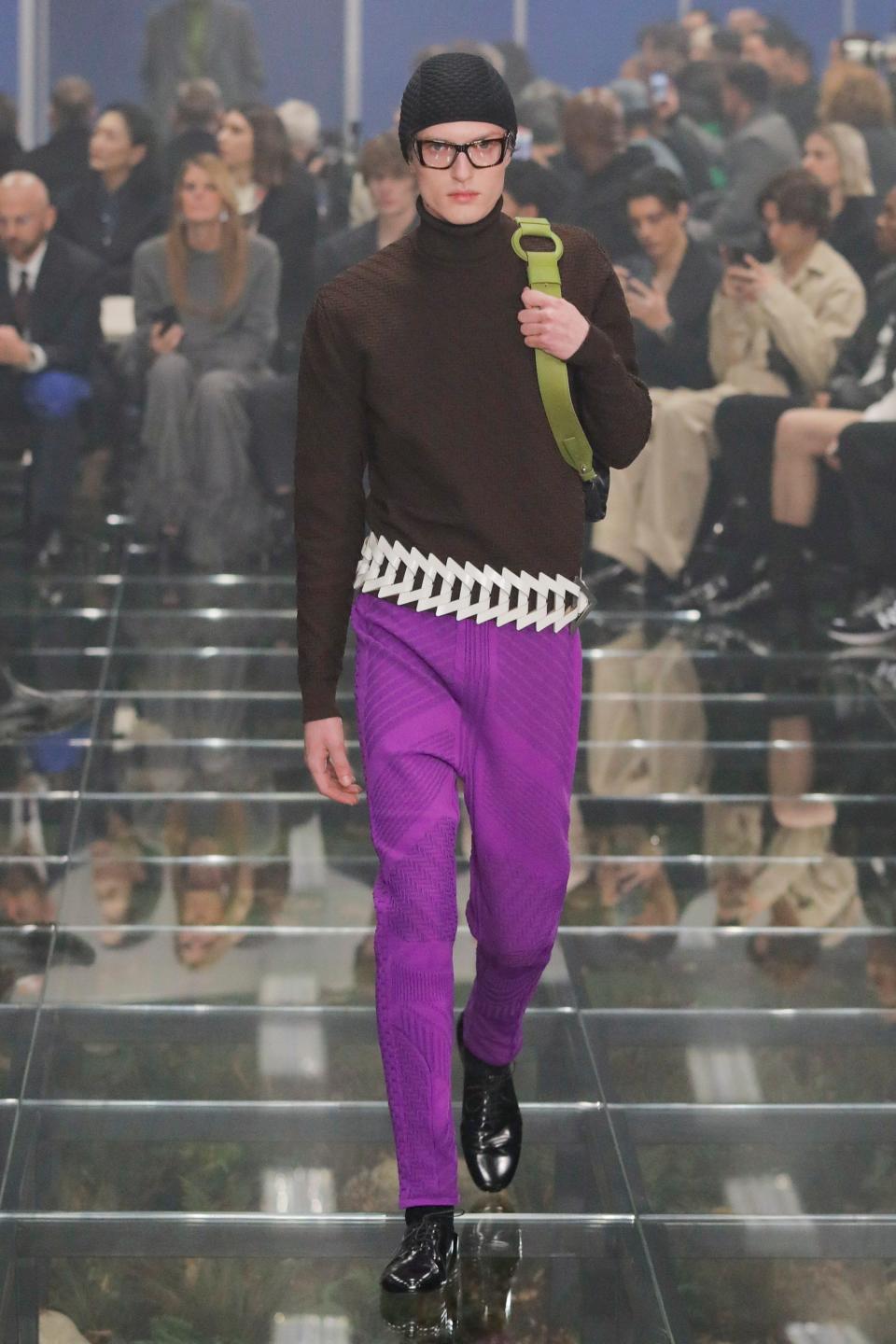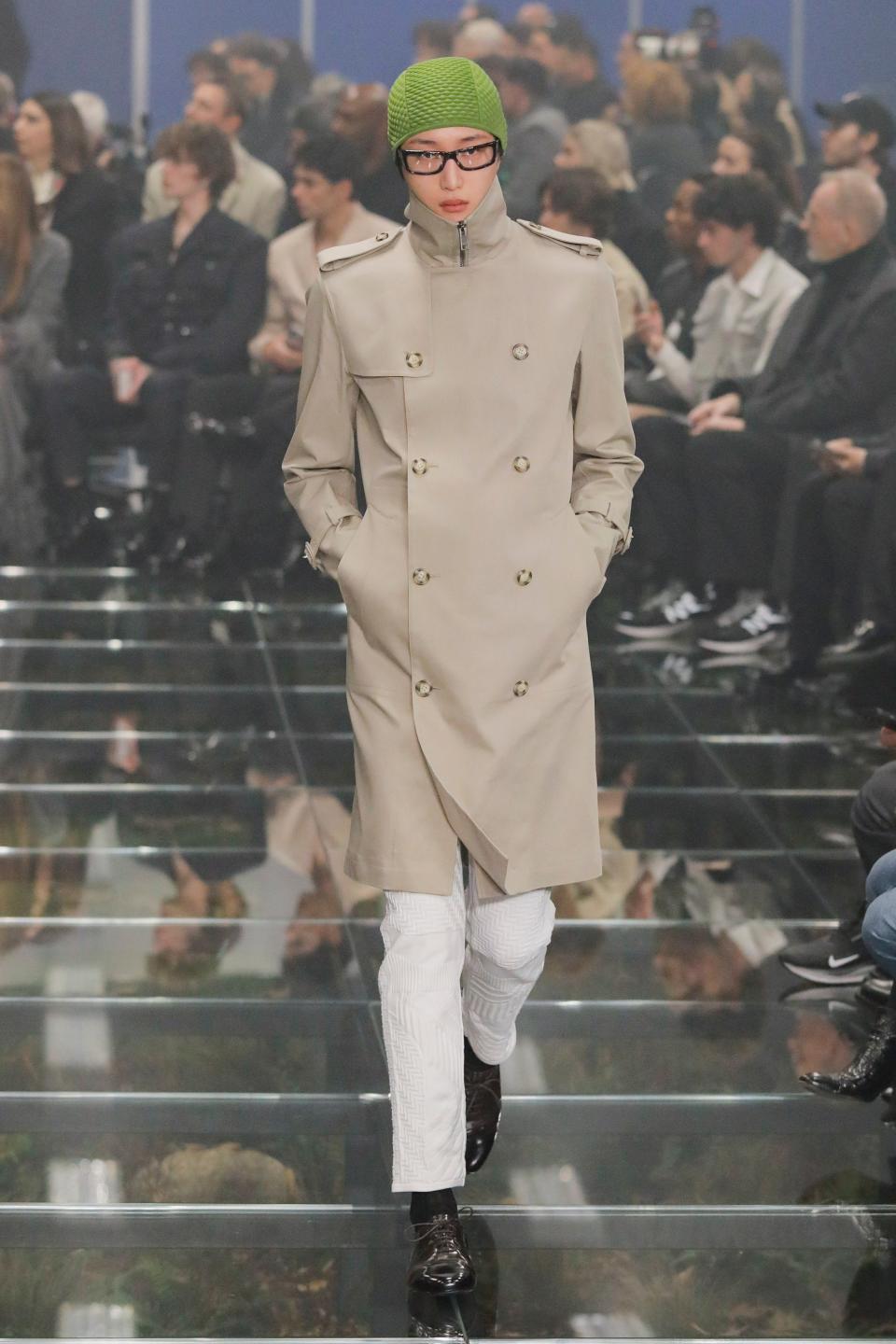How Does a Prada Show Actually Come Together?

- Oops!Something went wrong.Please try again later.
- Oops!Something went wrong.Please try again later.
This is an edition of the newsletter Show Notes, in which Samuel Hine reports from the front row of the global fashion week circuit. Sign up here to get it in your inbox.
Guests at Sunday afternoon’s Prada show in Milan entered through a maze of cubicles. Each desk had a computer monitor, booted up with a Prada-logo screensaver. “Depressing,” texted a friend watching the livestream. And then: “Wait, nevermind.” As you’ve probably seen on Instagram by now, we emerged into a sort of steamy corporate biosphere. Under a glass walkway in the Fondazione Prada auditorium was a mossy forest floor, complete with ferns and a burbling stream, an incredibly ambitious and surprising installation even by the standards of longtime Prada collaborator Rem Koolhaas, the Dutch architect who masterminds the physical Prada-verse. A Jurassic haze hung in the air.

“Unbelievable,” said a wide-eyed Troye Sivan. Sivane, Prada’s new campaign star, was walking to his front row seat in one of the hundreds of typical office chairs arranged around the room. “I’m so gagged,” he said. Sivan is a true Prada enthusiast who was flying from Australia to Milan for the shows well before he was on the brand’s billboards, so I asked him what he thought co-creative directors Miuccia Prada and Raf Simons had in store for us this season. “I feel like I know—I have a gut feeling.” He mentioned the words “super classy” and “sophisticated.” Of the set, he was definitive. “I knew there was going to be something special, but like, there’s water under the floor, you know what I mean? It’s really, really incredible.”
Funnily enough, Miuccia Prada had a much different take when she walked into the finished show space. “I think it’s menacing,” she said backstage. “For me, the impression I had when I first saw the result was that it was scary. The nature that you can’t touch through the glass, it’s scary.”
Prada always invites interpretation on many different levels, even by its own designers. Mrs. Prada and co-creative director Raf Simons’s work is enigmatic and dense, packed with a ton of ideas—some recent season points of reference have been the interiority (literally and emotionally) of man, the architecture of clothing, and the act of choice (i.e. “which coat should I choose, out of all the coats in the world?). At its best, a Prada collection can define a season of menswear, and the anticipation is intense because though the house has certain core codes, there’s really no telling what each collection will look like. (Just look at the difference between the corduroy-heavy ’70s vibes of FW17 and the sleek and futuristic SS18.)


Among the Milan Fashion Week crowd it’s a parlor game to feel around for a narrative as soon as show invitations are delivered, as they often offer hints of what’s to come. This season, the invite came with a simple Prada necktie and rumors that the co-creative directors were up to something unusual. Backstage, Mrs. Prada explained they were thinking about nature, specifically the relationship between the modern man and the great outdoors—hence the office terrarium. Of nature, she said, “We wanted to talk about something relevant, because in this moment you can’t ever talk about subjects that aren’t relevant,” she said.
It’s not always super clear, however, how Prada collections actually come together. How you interpret any fashion show has a lot to do with the intent of the designer, and Mrs. Prada and Simons (who began working together in 2020) don’t give a lot of interviews. Even when Mrs. Prada does speak, she can be cerebral to the point of inscrutability, introducing ideas and then the opposite of those ideas. She thrives in contradiction.
But after this show, Mrs. Prada revealed something interesting and potentially revealing about their process. Perhaps even more revealing than she intended.
“As always, first we do things, and after we find the reason,” she said. “A few days before the show, we analyze what we are doing, finding a title.”



Which might sound funny from a designer renowned as a singular genius. But it’s a frank (albeit brief) insight into her unique, non-linear creative process. And it reminded me of something Koolhaas told me in 2022. Describing how he and his firm AMO create the sets, the architect said of the designers, “They give us hints and suggest certain themes. So for instance, 20 years ago, there was a show where Miuccia Prada said: a little bit twenties, a little bit Charleston, and maybe some old-fashioned bicycles.” Mrs. Prada is reputed to start her own collections in the same abstract manner, which is then refined through conversations with the design team into its final statement. Up to, apparently, a few days before the show.
The tension between man and nature, control and instinct came through clearly. The show opened with a series of models wearing ties and contrast-collar banker shirts. Some wore blazers with rounded shoulders in heavy wools and tweeds, but these were no usual corporate warriors. On their heads were knit swimming caps, one of many nods to water throughout. “Most people's screensaver is nature, but then you know you sit in this very synthetic human made environment,” said Simons. “There were a million references,” he continued. “There was the businessman, the working man, the thinking man, and how does that sit with nature, which is the biggest contrast, in a way.”
As Simons explained it, these choices are guided by feeling rather than strict conceptual boundaries. “I think we start a lot of collections lately instinctively,” he said.



For her part, Mrs. Prada was considering our emotional connection to the changing seasons, and all the attendant modern anxieties. “What was most important was the relationship with seasons, that it was meant for going outside,” said Mrs. Prada. “Because usually [in my collections] there are no seasons—naked in winter, super covered [in summer]. But now I feel the need to be attached to something so basic for human nature like seasons. So the clothes relate with the outside, with weather, with reality.”
On the subject of climate change, Mrs. Prada repeatedly demurred—“There are so many political things attached, but we don’t want to enter in that”—but the show included plenty of the mid-season layering pieces that are becoming more essential thanks to our weird new weather. Some models emerged in trench coats cut in skinny columns, and a couple of coats came with balaclava-like hood attachments, open to the suit-and-tie below but tightly tied at the neck with scarves. Bright cardigans layered over contrasting sweaters conjured a warm fall afternoon.



The sketch was further filled in with knit long johns in funky, very-Prada colors—Simons cited the “very specific outfits” of the Elfstedentocht, a Dutch ice skating festival—worn with top coats. Simons listed more of the million references: “Man and water, man and the sea, a river, rain as water, swimming, human activity in relation to water whether it’s sporty or not sporty, a walk in the countryside or somebody who has a job like a mariner.” The country came through in heavy tweed trousers (an original form of rain protection) and canvas barn jackets, the sea in captain’s hats and long officer coats made of hand-distressed leather.
What I left thinking of was not the intellectual scaffolding but the parts of the collection that suggested novel and unconventional ways of styling oneself, like the form of the super-slim Oxford lace-ups under tapered slacks, and how the wide braided belts looked purely ornamental until they became bag straps. Even the knit long johns, a weird proportion for modern men if there ever was one, looked kind of cool paired with the big coats.



Simons suggested that ultimately something like this was the goal—renewal, achieved through contradictions in style. “We don’t really want to say, these are the codes you need to follow when you go in the office or these are the codes you need to follow when you go in nature,” he said. “I think we kind of tried to disturb each other, hopefully to come to something that feels contemporary.”
More experienced Prada-ologists than I (Troye Sivan?) might have deeper insight into how Mrs. Prada gets from “nature” to “Human Nature,” the title of the collection. But I think what she meant backstage is that as the clothes take shape they can reveal something sincere, intentional or not. Which raises an intriguing prospect, which is that Mrs. Prada and Simons are interpreting their work much in the same way their audience is. The way we experience and process and react to and ultimately reconcile a Prada show might just be true of their own process.



See all of our newsletters, including Show Notes, here.
Originally Appeared on GQ

